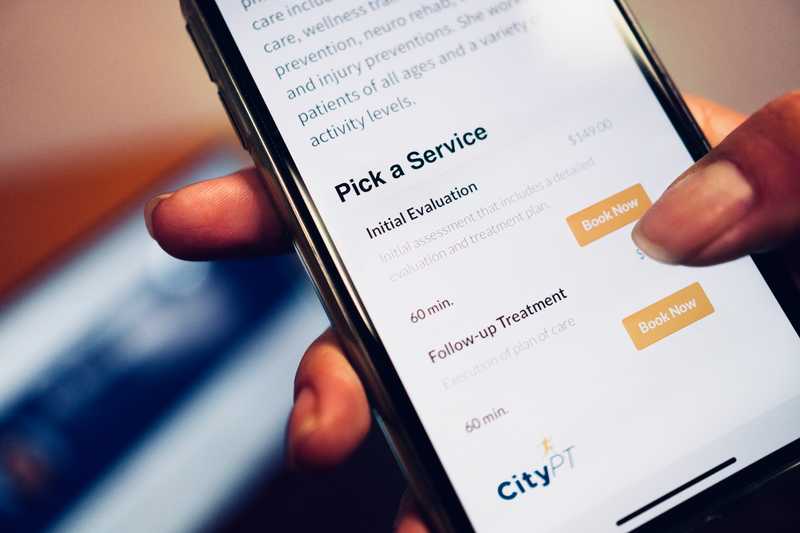Concierge physical therapy is a cash-based monthly service that follows the concierge medicine model. According to Dawnielle Robinson-Walker, a contributor at Forbes, "Concierge medicine — also known as concierge care, boutique medicine, retainer-based medicine, platinum practice and direct primary care — is membership-based healthcare that combines exclusive, personalized care with accessibility and convenience."
Key Takeaways
- Concierge physical therapy is a cash-based service (usually billed in monthly or annual dues) that follows the concierge medicine model. This is a convenient, boutique medicine approach that prioritizes the patient over set times, days, and treatment limitations.
- "Concierge physical therapy" is similar to the "mobile physical therapy" model of delivery that is rising in popularity, and also has benefits similar to telehealth, for both the patient and practitioner.
- Initial consultation and visit package costs can vary for patients seeking concierge physical therapy treatment options. A patient should expect to pay anywhere from $130 to $225 for an evaluation visit. And an 8-visit package will cost in the $750 to $1,225 range.
What is "Concierge" Physical Therapy?
Concierge physical therapy is a cash-based model of medicine that can improve treatment outcomes and the patient experience by eliminating common restrictions that slow healing. As part of monthly or annual dues, a patient is able to meet with a licensed physical therapist as needed, without limitations on session duration and treatment restrictions of traditional PT care.
Concierge physical therapists offer their services in a number of ways. For example, they may sell a monthly subscription or a 10-visit package that is designed to treat a specific condition. This enables patients to receive highly personalized care while at the same time purchasing visits at a bulk discount.
This type of model can also be extremely useful for those who need treatment brought to them. For example, Christy Manuel PT, DPT is owner of Body Renewal Physical Therapy, a mobile/concierge physical therapy practice serving patients in Naperville, IL. She operates with almost no inpatient setting and offers a wide array of services directly to the patient in the comfort of her home.
Concierge physical therapy is related to "mobile physical therapy" and telehealth physical therapy as all serve a similar need, depending on how they're positioned.
Benefits of Concierge Physical Therapy
If you're a private physical therapist, here are a few benefits of offering concierge physical therapy to your patients:
1. Patient Convenience and Comfort
For older patients, the allure of having someone come to treat them in the comfort of their own home can be quite a major benefit. They don't have to worry about travel, scheduling, or other accommodations, depending on their personal mobility.
In addition, at-home treatment can be a more comfortable setting for the patient overall, increasing the odds of a successful recovery.
2. Greater Financial Stability
Depending on the type of private practice model you're trying to deploy for your business, this cash-based model can be a great way to secure greater financial stability. Service charges are often billed as fixed rate "session packages" or through a monthly subscription fee or annual "dues."
As many outpatient clinic owners know, industry consolidation and falling insurance reimbursements have put considerable pressure on private practice owners, which is counterintuitive given the increasing demand for rehabilitative care. A study by Erik Carvalho, PT, DPT, OCS, Janet Prvu Bettger, ScD, and Adam P. Goode, DPT, PhD showed that "Musculoskeletal (MSK) conditions are the leading cause of disability in the United States (US), affecting more than 50% of the US population" and that "Over the past 4 decades, there have been substantial changes in the insurance coverage for therapy and rehabilitation services."
In context with these broader industry dynamics, selling PT sessions individually can result in volatile, hard-to-predict swings of income from month to month. This is why many clinic owners are considering a switch to a concierge, subscription based model.
3. Focus on the Patient
By choosing a business model that eliminates session time restrictions, you might be find yourself spending more time with your patients. And depending on your approach to care, this could be a positive thing for both you and the patient.
Better patient outcomes can lead to better patient reviews, referrals, and growth of your business. Improving a patient's quality of life is a great way to get natural word of mouth marketing to occur for your local business.
4. Lower Employment Fees
If you choose to go the complete "mobile physical therapy" route, you will have no office at all. This can significantly reduce your overhead. Based on this resource by Henry Sheyken, the average startup cost of a physical therapy clinic can be around $81,000 to $325,000 depending on the location and types of treatment you plan to offer.
While this is a pretty vast range, hiring and staffing is estimated to be around $50,000 to $100,000 of that initial startup fee.
5. Eliminate Your Leasing Costs
According to that same resource by Henry Sheyken, the average lease for physical therapy clinics is anywhere from $2,500 to $15,000 per month. For those looking to offer both mobile and telehealth services, this eliminates significant monthly overhead that's coming out of the clinics pocket.
Drawbacks of Offering Concierge Physical Therapy
Here are some of the potential drawbacks to offering concierge physical therapy services:
1. Securing Patient Payment
If you change to a cash-based model of care, you may find fewer people that are willing to purchase your services. Around 92% of the United States population has health insurance (according to Census.gov). Patients with health insurance typically want to utilize the benefits they currently receive from their employer.
2. Learning How to Manage Concierge Practices
For physical therapists who have spent years in the traditional healthcare setting, a concierge or "mobile" physical therapy practice might be more cumbersome to manage. This is usually a "one-person" operation (at least for those strictly offering mobile treatment services) and can cause a most of the operational tasks to fall onto the practitioner. For many clinicians, this is a really big drawback.
Consider a Hybrid Offering
Rather than offering concierge options at your practice or going full "mobile" physical therapy, consider adding a telehealth option. A study performed in 2022 found that telehealth demand grew by over 766%. With more patients becoming familiar with the benefits of telehealth, this can be a great way to provide hybrid options to your patients that give them more frequent and accessible access to treatment.
In this way, you can retain your brick-and-mortar rehabilitation center or in-person clinic and still provide the same level of care through telehealth services. In addition, you can offer these services as a cash-based model for a much lower fee than concierge services and get the added financial benefit for your practice while still delivering world-class patient care.
Give CityPT a Try
CityPT was designed to support new and experienced physical therapists who might want this type of hybrid model within their practice. Head over to our "For Therapists" page to learn all about our hybrid model for physical therapists and how easy it can be to start a practice in your area (and offer telehealth services to your patients).
References
- Understanding the Impact of COVID-19 on Health Systems in Low- and Middle-Income Countries: A Review of the Evidence and Recommendations for Policy and Practice. PMC, National Center for Biotechnology Information, 24 June 2022.
- Semega, Jessica, et al. Income and Poverty in the United States: 2022. United States Census Bureau, March 2023.
- FinModelsLab. Physical Therapy Startup Costs: A Guide to Starting Your Practice. FinModelsLab, 2023.
- PubMed. Publications by Carvalho E. National Center for Biotechnology Information.
- PubMed. Publications by Bettger JP. National Center for Biotechnology Information.
- PubMed. Publications by Goode AP. National Center for Biotechnology Information.
- Mobile Physical Therapy: A Promising Approach for Convenient and Effective Care. PMC, National Center for Biotechnology Information, 1 January 2023.
- Exer AI. How to Start a Mobile Physical Therapy Business. Exer AI Blog, 2023.
- Beaton, Thomas. What Is Concierge Medicine? Benefits, Costs, and Drawbacks. Forbes Health, 7 February 2023.



